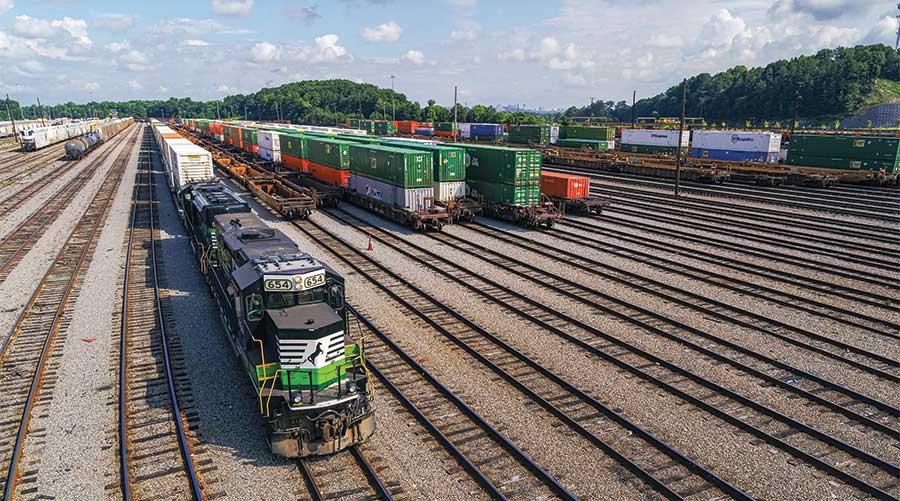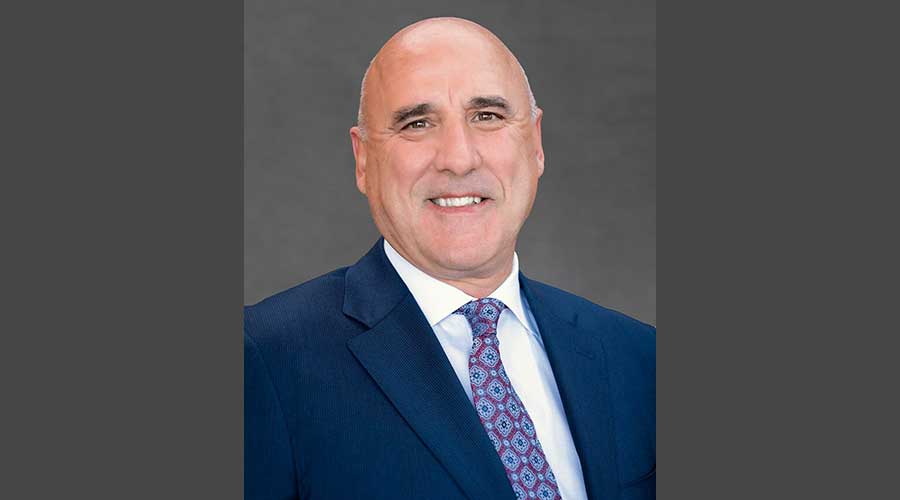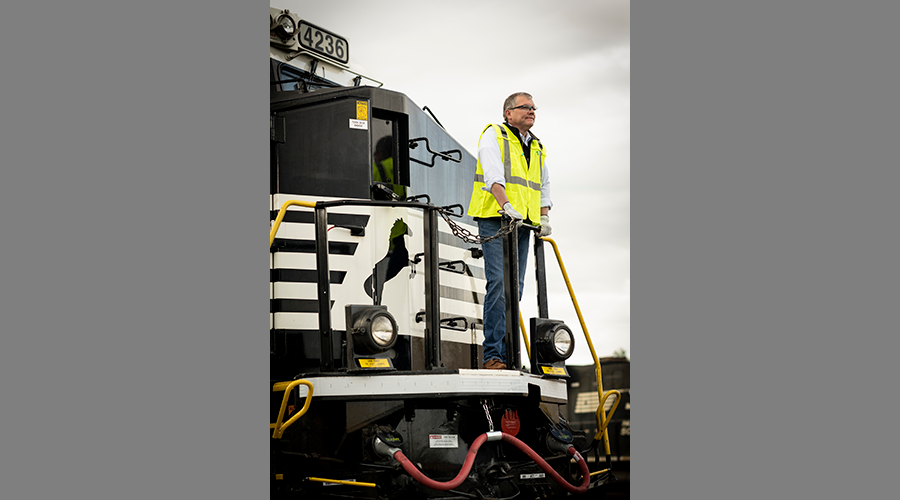Stay updated on news, articles and information for the rail industry
October 2024
Rail News: Norfolk Southern Railway
Despite a third major setback in two years, Norfolk Southern remains committed to business strategy

By Jeff Stagl, Managing Editor
Ed Elkins reaches out to customers often to gauge if Norfolk Southern Railway is providing the transportation service they need. The Class I’s executive vice president and chief commercial officer knows it’s extremely difficult to meet sales and marketing goals if the service product isn’t up to snuff.
Lately, what Elkins is hearing repeatedly during customer talks is NS’ service performance is better than it was just a short while ago. And many of them are ending conversations with the same advice for the railroad going forward: Keep it up.
That has a deeper meaning for NS than just for operational performance. The company needs to remain upright and continue cruising on its course toward key objectives rather than allow a recent series of bad maneuvers to torpedo the organization.
Over the past two years, three major setbacks have not only been huge impediments to NS but caused a lot of unwanted scrutiny, criticism and backlash from federal authorities, shippers, shareholders and other stakeholders:
- the major derailment in East Palestine, Ohio, that occurred in February 2023;
- Ancora Holdings Group LLC’s attempted takeover of NS and proposed overhaul of the Class I’s executive leadership and board in early 2024; and
- the Alan Shaw saga that quickly surfaced and boiled over in September.
Per the latter, NS’ board on Sept. 8 announced the launch of an investigation into allegations of potential misconduct by Shaw — at the time, the Class I’s president and CEO — that might have violated the company’s code of ethics and policy. The investigation found Shaw had an inappropriate relationship with NS EVP of Corporate Affairs, Chief Legal Officer and Corporate Secretary Nabanita Nag.
On Sept. 11, the board announced that Shaw and Nag were fired for cause, and EVP and Chief Financial Officer Mark George was appointed president and CEO. At the time, Jason Zampi was installed as acting CFO and Jason Morris was named acting corporate secretary. But then on Sept. 24, NS announced the appointments of Zampi as EVP, CFO and treasurer, and Morris as senior VP, CLO and corporate secretary.
George joined NS nearly five years ago after serving as CFO for several companies, including Carrier Corp., Otis Elevator Co. and UTC Building & Industrial Systems. Now, he aims to take the wheel and guide NS away from all the negativity that taxed employees and hindered the company, and toward a period of positivity that — hopefully — begets growth and prosperity.
The leadership team is doubling down on a commitment to profitability, productivity and efficiency targets, such as generating $250 million in cost and productivity savings this year followed by another $150 million in 2025, and eventually reaching a sub-60 operating ratio.

The targets are part of the company’s overall strategy, which includes attaining reliable and resilient service as a top goal. Other strategic objectives call for exploiting the railroad’s network advantages, such as connections to many major U.S. population centers and consumer markets; unlocking additional capacity for growth; making significant investments in infrastructure; and leveraging new technologies to enhance service and the customer experience.
What’s important for NS customers and partners to know is that the railroad isn’t slowing down or stagnating, George stated in an email.
“We’re making safety the foundation of everything we do and making sure our railroaders have the resources they need to be able to operate with excellence every day,” he says. “This is what customers are looking for in a partner they rely on for their own business.”
Keeping the bat on the ball
Independent transportation industry analyst Tony Hatch believes the Class I is charting a favorable path with George and the stated approach, even though Hatch doesn’t know George personally and favored the selection of former CN leader and current NS board member Claude Mongeau as at least the interim CEO to replace Shaw.
NS has maintained that the recent “third strike” involving Shaw was a foul tip and they were still at bat, while the ultimate umpire — the stock market — has seemingly ruled in their favor, wrote Hatch, also a Progressive Railroading columnist, in a note to his clients.
“Relations with their investors, given recent history, is essential,” he said.
In terms of external pressures, NS was always going to face a two-step process: margin, and then resiliency/growth, Hatch added.
Going forward, the senior team must ensure the strategic pillars of service, safety, productivity and growth remain steadfast to garner success and position the railroad to be a larger part of shippers’ supply chains, NS leaders say.
George stresses that mediocre operational performance — which mostly describes the state of the Class I’s service before the second quarter — won’t be tolerated.
The railroad needs to deliver the service that customers can count on from a provider they can trust, says Elkins. And there’s beginning to be more practicing than preaching in that regard.
“Lately, we have been on a trajectory of service improvement,” says Elkins.
The start of more solid service metrics coincided with the hiring of Class I operating guru John Orr in March under Shaw’s watch. Now NS’ EVP and chief operating officer, Orr over his 40-year career has built a reputation as a proven leader in applying scheduled railroading principles at several Class Is, including Canadian Pacific Kansas City, Kansas City Southern and CN.
The Orr effect
Orr created a task force and a “war room” in NS’ network operations center where a team assesses network-wide asset utilization and identifies, analyzes and corrects operational issues, which helps pinpoint root causes and permanently fix service problems. He also developed a network “heat map” to identify route blockages and increase train speed.
Elkins works closely with Orr; they meet three times per week to discuss operational performance and any impacts on sales and marketing efforts.
“It’s been a healthy process for us. He is interested in fluidity and our growth opportunities, and going after them,” says Elkins.
Now, average train speed is up. In addition, terminal dwell time recently reached its lowest level since third-quarter 2021 and car miles per day — which is most indicative of network performance — reached its highest mark since second-quarter 2021, says Elkins.
The leadership team is energized by the significant operational improvements, says George.
“It’s hard to argue with the core tenants of a strategy that prioritizes safe, reliable and consistent service so that we can grow our business while being as productive and efficient as possible,” he says. “The improvements we’re making in our service product are allowing us to move current freight more efficiently, earn the trust that wins freight we previously lost to truck and bring new freight to our network.”

The combination of winning back and earning new business was evident in the second quarter, when NS led the industry in volume growth. Elkins and the sales/marketing team are communicating with customers every day, working to align their needs with NS’ commercial strategy, says George.
NS is regaining volume in several sectors — particularly service-sensitive intermodal and automotive traffic — because of service improvements.
Intermodal intentions
In Q2, intermodal traffic climbed 8% year over year and reached a post-pandemic high. With service performance heading in the right direction, the railroad can better exploit its intermodal franchise, Elkins believes.
NS has the best intermodal network due to the large number of consumers in its service area and the reach of its “nodes,” or terminals, he says. The network reaches more than 50% of the U.S. population and is the most extensive intermodal franchise in the eastern United States.
“Because of the long runway with better service now, we are building trust with customers,” says Elkins.
For example, several premium (or parcel/less-than-truckload) customers recently turned to NS to handle more of their freight. The railroad also is gaining traction with building intermodal traffic in conjunction with business partners, such as The Hub Group and J.B. Hunt Transport Inc.
In October, NS expects to introduce new intermodal routes with CPKC that will link Mexico and Midwest markets, says Elkins. NS already has launched an intermodal service with CN that targets traffic reaching such markets as Kansas City and Atlanta.
Overall, 53 low-volume lanes with limited growth prospects — totaling 15% of all intermodal lanes — were removed. The effort helped reduce network complexity, freed resources to improve service in lanes with greater strategic value to customers, and reduced conflicts with the merchandise network’s speed and efficiency.
“We kept the lanes we feel good about,” says Elkins, citing as an example a route that serves a busy inland port in Greer, South Carolina, which is located about 200 miles from the Port of Charleston.
Coming soon in the Southeast
NS leaders also feel good about the railroad being positioned to serve the Georgia Ports Authority’s new Blue Ridge Connector inland terminal in Gainesville, Georgia, when it opens in 2026. The railroad will link the terminal to the authority’s Mason Mega Rail terminal in Savannah.
The terminal will serve a range of industries, including consumer goods, heavy equipment, food and forest products. It will feature 18,000 feet of track and conduct about 200,000 lifts annually.
Georgia is among the fastest-growing states in terms of population, industrial output and freight movements. Thus, the authority is an important partner to NS, says Elkins. The railroad aims to target more traffic from Savannah to Atlanta — an intrastate move that’s rare with intermodal, he adds.
NS leaders are enthused, too, about their recent decision to invest more than $200 million in improvements to the 3B Corridor, a key Alabama line that connects markets in the state’s northern and central regions to the Port of Mobile. The move positions the corridor to accommodate expected growth in several sectors — including intermodal-related traffic — as the Southeast continues to become an economic powerhouse for the U.S. economy.
The corridor represents an important segment of NS’ annual traffic, serving such critical industries as agriculture, automotive, chemicals, forestry and steel. More than 40 customers will be supported by the project.
The railroad plans to carry out a mix of terminal and track-based infrastructure improvements, including capacity projects in central and southwest Alabama, customer-specific projects in north Alabama and locations north of Mobile, yard upgrades in Wilton and a series of grade crossing improvements throughout the region. More than 21 miles of track will be built.
NS leaders expect the large investment to yield immediate returns when improvements come online in 2025.
“The corridor cuts through the heart of Alabama and touches industrial development in the Southeast,” says Elkins. “This preps us to be ready for traffic opportunities that are coming on board.”
NS already is collaborating on a 3B Corridor project with a high-volume metallurgical coal customer. A premium met coal production facility is set to be developed along the route in 2025.
In addition, Packaging Corp. of America recently expanded its paper mill along the corridor. The project is expected to enhance efficiencies for both companies.
“Without Norfolk Southern’s investment in the region, we would not have been able to maximize the opportunity to ship more volume via rail,” said PCA Vice President of Transportation Ross Corthell in a press release.
More autos in the mix
In addition to being a major intermodal player, NS is the largest transporter of auto products and metals in North America. In April, the railroad placed intermodal and automotive operations — which previously were managed by the marketing division — under Orr.
The change instilled additional operational rigor, enhanced opportunities for further productivity, and improved alignment and coordination across the business, including in the merchandise and bulk businesses, NS leaders say.

Similar to what’s happening with the intermodal franchise, improved operational performance is paying off in more automotive business. Two finished vehicle manufacturers that dropped rail several years ago to instead use trucks recently became NS customers, says Elkins.
“Because of better service and more trust, they have come back to rail,” he says. “Better service gives us the bandwidth to grow other parts of the franchise.”
That includes traffic generated with short-line partners. Earlier this year, NS formally launched a Short Line Performance Project designed to improve communication and information sharing with short lines to boost interchange performance.
Key links to traffic growth
Short lines help generate more than 40% of NS’ industrial products traffic annually, so the Class I’s connections to more than 200 short lines are key links to traffic growth. Over the past several years, many interchanges between NS and small railroads have been inconsistent, which impacted service performance and jeopardized potential carload growth.
Now, a Short Line Performance team aims to ensure consistent interchange service via more meticulous carload tracking and real-time communication on traffic exchanges.
NS’ Business Development and First and Final Mile Markets Division has employed the unique approach to improve local-level service and expand business opportunities beyond NS railheads, says Elkins. The project has driven a 5.2% increase in short-line interchange volume since March.
“We are very proud of this new short-line program. It has helped improve the frequency and predictability of interchanges,” says Elkins. “It’s a perfect example of the phrase, ‘Service begets growth.’ And it hasn’t required any new track or capital expenditures to do it.”
There are other ways NS is attempting to build more volume, as well. For example, a field sales group staffed with 20 to 30 sales/marketing employees is charged with growing business locally all along the network. The group has been in place about three years.
“The goal is to increase revenue per every switch on the network,” says Elkins. “We lost business the past few years because of service and now are trying to win it back. The aim with the group is to gain back lost business as well as get new business.”
NS leaders are also open to suggestions when it comes to traffic generation and operational performance. The Class I now is forming its first-ever customer advisory board to glean input from shippers.
Other Class Is have used such boards for some time. NS’ customer advisory board will include 12 to 15 members.
“We expect the board to have its first meeting by the end of the year,” says Elkins. “We’ll gain feedback and collaboration from key customers.”
It’s going to take a lot of collaboration and a lot of teamwork for NS to further distance itself from the recent trials and tribulations. George believes the company is turning the page on that brief bleak history and is ready to write more hopeful chapters.
“We are making great progress on so many levels and our future has never been brighter,” he says. “The company and our employees have a long history of being successful, and all 20,000 of our railroaders are looking forward to staying true to our mission and continuing to drive progress — together.”
Email questions or comments to jeff.stagl@tradepress.com.
Keywords
Browse articles on Norfolk Southern Railway Mark George Alan Shaw East Palestine Ancora Holdings Group LLC John Orr Ed Elkins Tony Hatch rail service intermodal Blue Ridge Connector 3B Corridor Short Line Performance Project Business Development and First and Final Mile Markets DivisionContact Progressive Railroading editorial staff.


 2025 MOW Spending Report: Passenger-rail programs
2025 MOW Spending Report: Passenger-rail programs
 Gardner steps down as Amtrak CEO
Gardner steps down as Amtrak CEO
 Guest comment: Oliver Wyman’s David Hunt
Guest comment: Oliver Wyman’s David Hunt
 Women of Influence in Rail eBook
Women of Influence in Rail eBook
 railPrime
railPrime







